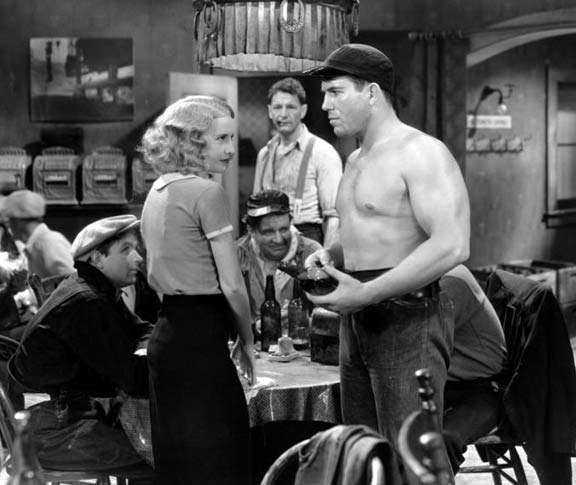Wednesday, October 22, 2014
Baby Face (1933)
Pre-Code movie starring Barbara Stanwyck as a very bad girl, that is, if you believe that sleeping with whomever you need to at any given time to rise in the world is bad. Many people probably don't believe this, especially nowadays, but enough did in 1933 that this is credited as one of the main films that precipitated the establishment of the Code, which of course restricted the amount of moral deviancy that could be shown, especially in anything resembling a celebratory manner, until well into the 1960s.
Aside from the more egregious deviancy, the America depicted in Baby Face in general is a much rawer, uglier, cruder, beastlier place than that depicted in the polished classics of the Code era that was to begin within a few years, and which has a tendency to induce nostalgia for many aspects of that era in some people. The dingy, firetrap speakeasy, supposed to be in Erie, Pennsylvania, where Baby Face works (and lives) when the movie begins, with its rotting walls and peeling wallpaper and tiny window looking out on a row of smokestacks barely visible through the thick pollution, in which she cannot walk more than three steps without being molested by sweaty, violent, and uninhibited factory workers in various states of undress (and in which she later gives out her father has been pimping her out to the clientele since she was fourteen), is convincingly appalling. Life in this ghetto has little object beyond day to day survival and the periodic satisfaction of one's animalistic urges. Such ambition as there is consists entirely of schemes which involve either exploiting or swindling whomever lays conveniently to hand for the purpose. Baby Face eventually makes her way to New York, and that is not quite as hopeless, but even the atmosphere there, with its characteristic 30s emphases on sleek modernistic and art deco designs and the massive gulf in wealth between the elite and the ordinary schmoes, is cold and forbidding compared to how it would be depicted once the New Deal ethos began to kick in towards the end of the decade.
When I say that Baby Face sleeps her way to the top, she really has to start from the bottom. The first lucky fellow is the guy whose job it is to throw vagabonds out of the boxcars, whom she has to placate to even get to New York; and then when she gets there it's the fat slob whose job is to sit at the reception desk and keep the unemployed hordes at bay's lucky day. (That guy is at about my occupational level--today of course any woman ambitious enough to be willing, and alluring enough to be able, to rise by this means would at least be able to start out much higher up the ladder and get to skip these gross early steps). The further up she goes, the more havoc she wreaks in careers and personal lives and the less able the men seem to be either to resist her initial advances or to get over her once she has gotten them fired and broken up their engagements, and moved onto the next guy on the chain.
By the way, back in Erie, there is a German-accented old-timer in the 'hood who, in spite of his own seemingly lowly station, is into Nietzsche, and introduces Baby Face to some of that philosopher's most famous concepts, though the application of these in the film strikes me as the product of a decidedly sub-Straussian interpretation.
I don't love this movie, though I don't think it is supposed to be a great work of art so much as an interesting artifact of the zeitgeist of its period, as well as a showcase for the talents of Barbara Stanwyck, whom many connoisseurs of both film and women consider to be one of the greatest movie actresses of all time. I have to admit I do not really get the mystique of Barbara Stanwyck yet either. Some people think you either get something right away or you never get it--there is never any in-between ground with such people--but I often find that after multiple exposures to or efforts with poets, directors, actors and so on that I will begin to see something that I can appreciate or perceive some hint of greatness in.
I was going to write something about the folly of imagining what past times were like based on their presentation in movies, using the pre-Code/post-Code divide, when all manner of vice and bawdiness suddenly took on much more subdued and socially marginalized forms, as an example of this. But I am not sure that I believe it is all folly. The Depression era, especially after the election of Roosevelt, was a period of dramatic change. The centralization and overall tighter organization of society compared to what had existed previously could not fail to insinuate its effects into movemaking and other artworks. The crime rate did begin to plunge precipitously right around the time the Code was instituted (and ironically did not start shooting up again until the time it was lifted). We are so well trained to be suspicious now of the boldface narratives that formerly held sway in this country and assume they were all lies to cover up what was really going on that you almost have to look at what is not calling attention to itself or perhaps even conscious of itself in these old books and films to try to give yourself a persuasive idea of what was authentically happening or important at the time.
Subscribe to:
Post Comments (Atom)





No comments:
Post a Comment